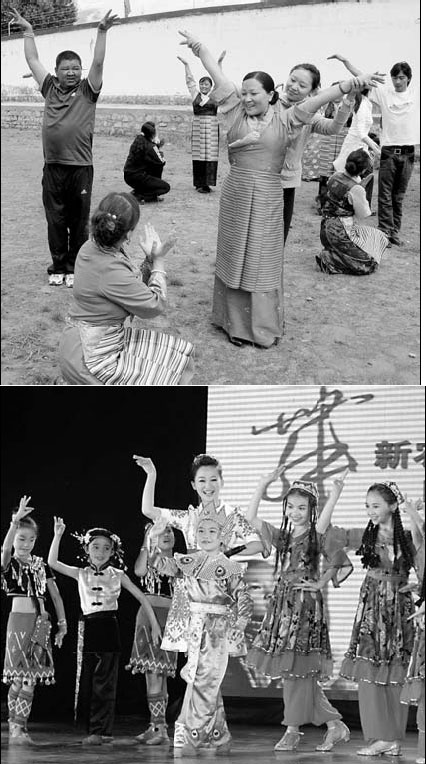Life and Leisure
Teachers dance to kids' tunes
By Zhi hua (China Daily)
Updated: 2010-09-07 08:07
 |
Large Medium Small |
|
Top: Primary school teachers in the Tibet autonomous region learn children's dance under the guidance of the dancers from the China Dancers Association. Above: Rural children from Yunnan and Xinjiang Uygur autonomous region rehearse for a dance performance. Photos provided to China Daily |
Jin Shan never thought that one day she would be teaching thousands of adults all over the country children's dances.
The China Dancers Association (CDA) teacher comprises 16 teachers leading a program called "Dance Education Program for Rural Children", that began in May 2007.
"While we may not be able to create the same conditions for kids in the countryside as in the cities, we can at least help them glimpse the beauty of dance," says Mao Hui, chief editor of China Dance, the magazine put out by the association, explaining the motive behind the program.
The association's teachers have been cooperating with local governments to train rural teachers who, in turn, are expected to open the eyes of their students to dance.
All the pieces are easy to learn and interesting to perform, and more importantly most do not call for props.
The association covers all costs of travel and lodging for its trainers, and doesn't charge any fees from the rural teachers. Free textbooks and videos are also made available.
"To date, we have held 160 training classes for 5,808 rural teachers, covering 29 provinces," says Lu Changzhou of the CDA.
The very first training class was held in Ansai county, Yan'an, Shaanxi province, in May, 2007.
Forty-two teachers from 16 local schools assembled in a local hall to follow the instructions of their trainer Jin.
Some of them were music or art teachers, some were Chinese Language or mathematics teachers, and some, PE teachers. None was a teacher of dance.
"Many rural schools cannot afford to hire a professional for even the mandatory music course, let alone for the 'luxury' of a dance course," says Bai Xue, another trainer.
Despite the presence of folk dances in some places, in most cases, dance is absent from the daily lives of rural children, says the editor Mao Hui.
Recalling the early days of the program Jin says: "Most of those we trained were completely new learners, and were very shy."
Ranging in age from 20 to 50, they were mostly female.
The first day Jin had to be mindful of not hurting her bashful and hesitant students inadvertently.
"I had to weigh every word carefully. I made sure I never said, 'that's wrong, we need to do it again', instead saying, 'that's great! Let's do it once more'."
Combining words with non-verbal language, Jin tried her best to ensure her trainees understood her.
The second day was much better as the trainees' curiosity and confidence got the better of their shyness.
Jin was struck by their sincerity, saying they gave her their full attention in class and continued their practice after class.
Jin and her colleagues tried to make sure their trainees understand the meaning of each dance mix.
"That way they would be able to pass on more to the children and make it easier for them," Bai says.
"We now have dances more appropriate for children than our folk dance, such as Yangge," says Liu Xiaoling, a music teacher at No 1 Primary School of Ansai town.
Yangge is one of the most representative folk dances of North China, wherein dancers dressed in colorful costumes, typically with a red silk ribbon tied around the waist, swing their bodies to music played by the drum, trumpet and gong.
Liu says her students love the dances she has learnt from the association.
In July last year, the association invited about 300 children who had benefited from the program to perform at the Chinese People's Political Consultative Conference Hall. They included some of Liu's students.
China Daily
